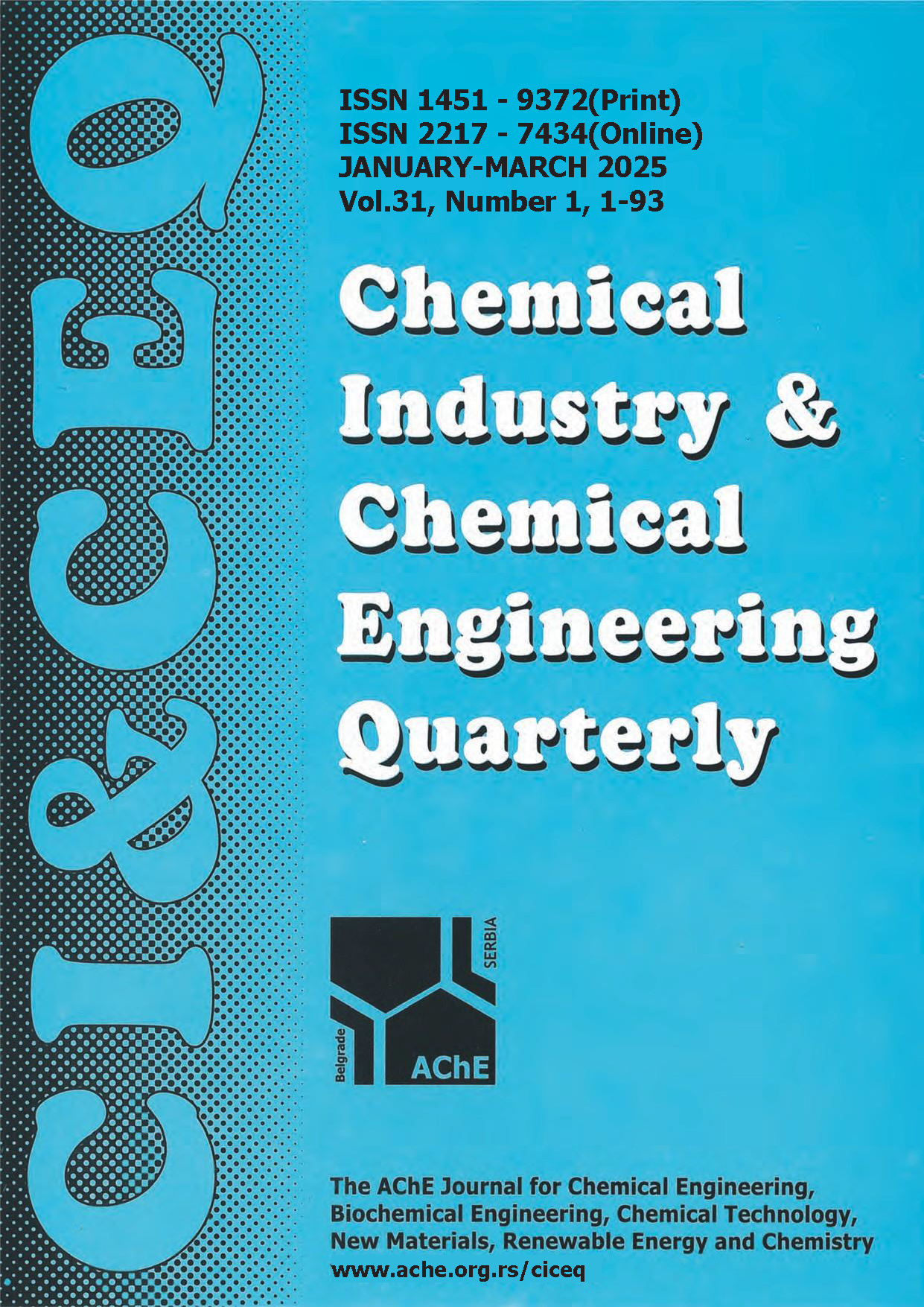SIMULTANEOUS MULTI-OBJECTIVE FRAMEWORK OF NATURAL GAS PIPELINE NETWORK OPERATIONS
Original scientific paper
DOI:
https://doi.org/10.2298/CICEQ231203016MKeywords:
Gas pipeline network, multi-objective optimization, power demand, topsis, line pack, mathematical modelingAbstract
The optimization of gas transportation networks is essential as natural gas demand increases. Conflicting objectives, such as maximizing delivery flow rate, minimizing power consumption, and maximizing line pack, pose challenges in this context. To address these complexities, a novel multi-objective optimization method based on the Technique for Order of Preference by Similarity to Ideal Solution (TOPSIS) is proposed. The method generates a diverse set of Pareto optimal solutions, empowering decision-makers to select the most suitable solution for gas transportation networks. Three case studies validate the approach's effectiveness, showcasing its advantages in yielding more economical networks and enhancing the cost-effectiveness of natural gas transmission networks. The proposed method's versatility allows application to various gas transportation network scenarios. Decision-makers benefit from a range of Pareto optimal solutions, providing valuable insights. Moreover, the seamless integration of the proposed method into existing gas transportation network optimization frameworks further enhances performance. In conclusion, the study presents a robust multi-objective optimization method based on TOPSIS for gas transportation network optimization. It offers cost-effective solutions and improves the efficiency of natural gas transmission networks. The provision of diverse Pareto optimal solutions enables well-informed decision-making, contributing to sustainable energy solutions in the face of increasing natural gas demand.
References
[1] X. Wu, C. Li, Y. He, W. Jia, Math. Probl. Eng. (2018)1267045. https://doi.org/10.1155/2018/1267045.
[2] C.Li, W.Jia, E.Liu, X. Wu,Int. J. Ind. Eng.19 (6) (2012) 241—251. https://doi.org/10.23055/ijietap.2012.19.6.631.
[3] S. Mokhatab, W.Poe, J.Mak, Handbook of natural gas transmission and processing: principles and practices, Gulf Professional Publishing, (2018) ISBN:0128016647, 9780128016640.
[4] A. Kashani, R. Molaei, Chem. Eng. Res. Des.92 (2014) 2106—2122. https://doi.org/10.1016/j.cherd.2014.02.006.
[5] X. Wu, C. Li, W. Jia, Y. He, J. Nat. Gas Sci. Eng. 21 (2014) 10—18. https://doi.org/10.1016/j.jngse.2014.07.028.
[6] H. Üster, Ş. Dilaveroğlu, Appl. Energy133 (2014) 56—69. https://doi.org/10.1016/j.apenergy.2014.06.042.
[7] F.da Silva, J.de Souza, A.Costa, Comput. Chem. Eng.93(2016) 212—220. https://doi.org/10.1016/j.compchemeng.2016.06.006.
[8] H. Su, E. Zio, J. Zhang, X. Li, L. Chi, L. Fan, Z. Zhang, Comput. Chem. Eng.131 (2019) 106584. https://doi.org/10.1016/j.compchemeng.2019.106584.
[9] K. Liu, L.Biegler, B. Zhang, Q. Chen, Chem. Eng. Sci. 215 (2020) 115449. https://doi.org/10.1016/j.ces.2019.115449.
[10] Q. Chen, C. Wu, L. Zuo, M. Mehrtash, Y. Wang, Y. Bu, R. Sadiq, Y. Cao, Comput. Chem. Eng.147 (2020) 107260. https://doi.org/10.1016/j.compchemeng.2021.107260.
[11] X. Yin, K. Wen, Y. Wu, X. Han, Y. Mukhtar, J. Gong, J. Nat. Gas Sci. Eng.98 (2022) 104384. https://doi.org/10.1016/j.jngse.2021.104384.
[12] E. Menon, Gas pipeline hydraulics, Online Course (2005). https://doi.org/10.1201/9781420038224.
[13] P. Coelho, C. Pinho, J. Brazilian Soc. Mech. Sci. Eng.29 (3) (2007) 262—273. https://doi.org/10.1590/S1678-58782007000300005.
[14] M. Mohitpour, H. Golshan, M. Murray, Pipeline Design & Construction: A Practical Approach, 3rdEd, American Society of Mechanical Engineers, (2007). https://doi.org/10.1115/1.802574.
[15] K. Pambour, R. Bolado-Lavin, G.Dijkema, J. Nat. Gas Sci. Eng. 28 (2016) 672—690. https://doi.org/10.1016/j.jngse.2015.11.036.
[16] A. Demissie, W. Zhu, C. Belachew, Comput. Chem. Eng.100 (2017) 94—103. https://doi.org/10.1016/j.compchemeng.2017.02.017.
[17] T.Edgar, D.Himmelblau, L.Lasdon, Optimization of chemical processes, McGraw Hill, New York,(2001). https://doi.org/10.1002/aic.690490128.
[18] C. Hwang, K. Yoon, Multiple Attribute Decision Making: Methods and Applications, 1st Ed, Springer, Berlin 186 (1981) 58—191. https://doi.org/10.1007/978-3-642-48318-9.
[19] S. Wu, R. Rios, E. Boyd, L. Scott, Math. Comput. Model. 31 (2000) 197—220. https://doi.org/10.1016/S0895-7177(99)00232-0.
[20] F.Tabkhi, L. Pibouleau, C. Azzaro, S. Domenech, J. Energy Resour. Technol. 131 (4) (2009) 043002. https://doi.org/10.1115/1.4000325.
[21] D. Zhou, X. Jia, S. Ma, T. Shao, D. Huang, J. Hao, T. Li, Energy. 253 (2022). https://doi.org/10.1016/j.energy.2022.124068.
[22] J. Zhou, J. Peng, G. Liang, C. Chen, X. Zhou,Y. Qin, J. of Intell.& Fuzzy Systems. 40(3) (2021). 4345—4366. https://doi.org/10.3233/jifs-201072.
[23] M.H.H. Mohamed, H.A.A. Gawad, Deci. Making: Applic. in Manag. and Eng. 7, (2024) 420—441. https://doi.org/10.31181/dmame712024983.
Downloads
Published
Issue
Section
License
Copyright (c) 2023 Mostafa Hassanei Hussein Mohamed

This work is licensed under a Creative Commons Attribution-NonCommercial-NoDerivatives 4.0 International License.
Authors who publish with this journal agree to the following terms:
Authors retain copyright and grant the journal right of first publication with the work simultaneously licensed under a Creative Commons Attribution License that allows others to share the work with an acknowledgement of the work's authorship and initial publication in this journal.
Authors grant to the Publisher the following rights to the manuscript, including any supplemental material, and any parts, extracts or elements thereof:
- the right to reproduce and distribute the Manuscript in printed form, including print-on-demand;
- the right to produce prepublications, reprints, and special editions of the Manuscript;
- the right to translate the Manuscript into other languages;
- the right to reproduce the Manuscript using photomechanical or similar means including, but not limited to photocopy, and the right to distribute these reproductions;
- the right to reproduce and distribute the Manuscript electronically or optically on any and all data carriers or storage media – especially in machine readable/digitalized form on data carriers such as hard drive, CD-Rom, DVD, Blu-ray Disc (BD), Mini-Disk, data tape – and the right to reproduce and distribute the Article via these data carriers;
- the right to store the Manuscript in databases, including online databases, and the right of transmission of the Manuscript in all technical systems and modes;
- the right to make the Manuscript available to the public or to closed user groups on individual demand, for use on monitors or other readers (including e-books), and in printable form for the user, either via the internet, other online services, or via internal or external networks.




